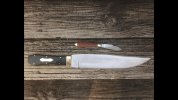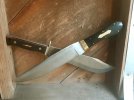-
The BladeForums.com 2024 Traditional Knife is available! Price is $250 ea (shipped within CONUS).
Order here: https://www.bladeforums.com/help/2024-traditional/
You are using an out of date browser. It may not display this or other websites correctly.
You should upgrade or use an alternative browser.
You should upgrade or use an alternative browser.
Traditional knife homework - Blade length to handle length ratio.
- Thread starter Just Tom.
- Start date
Because you don’t cut with the tang, and some knives have enormous ones.Why are we omitting the length of the tang?
black mamba
Gold Member
- Joined
- Oct 21, 2009
- Messages
- 23,560
I know that among GECs the #12 Toothpick (4"), the #48 Trapper (3⅞") and the #53 Cuban (4⅛") all share the same 3" muskrat clip main, so the #48 has a very favorable ratio of .77.
afishhunter
Basic Member
- Joined
- Oct 21, 2014
- Messages
- 14,760
Measuring just the straight no belly portion of the blade edge, per post number 1, and dividing by the handle length, My calculator says "ERROR".Guys, it’s just 2 easy measurements, and simple division. It’s GOT to be a whole lot easier than remembering some obscure pattern number from a 1910 cutlery catalog or something…
0mm /33mm= "error"
View attachment 2045742
The cutting edge is 100% belly.
5K Qs
Gold Member
- Joined
- Jul 20, 2014
- Messages
- 15,792
Here are the edge/handle ratios for several knives that I usually keep in the kitchen and use for food prep. (All measurements, and hence ratios, are approximate; ratios computed to the nearest hundredth.  )
)
Rosewood Hartshead Barlow: 6.1cm/ 9.5cm = .64
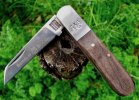
Victorinox folding paring knife: 10.3cm/13cm = .79
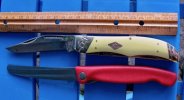
Rough Rider folding hunter: 9.2cm/13.3cm = .69 (Edge of both clip and skinner blade are 9.2 cm, so same ratio for either blade.)
RR mini canoe - main blade: 4.2cm /6.9cm = .61
RR mini canoe - secondary blade: 3.2cm/6.9cm = .46 (I'm curious about proportionality between mini canoes and standard canoes, so I measured both blades here, and will do the same for a full-sized canoe later.

- GT
Rosewood Hartshead Barlow: 6.1cm/ 9.5cm = .64

Victorinox folding paring knife: 10.3cm/13cm = .79

Rough Rider folding hunter: 9.2cm/13.3cm = .69 (Edge of both clip and skinner blade are 9.2 cm, so same ratio for either blade.)
RR mini canoe - main blade: 4.2cm /6.9cm = .61
RR mini canoe - secondary blade: 3.2cm/6.9cm = .46 (I'm curious about proportionality between mini canoes and standard canoes, so I measured both blades here, and will do the same for a full-sized canoe later.

- GT
Measuring just the straight no belly portion of the blade edge, per post number 1, and dividing by the handle length, My calculator says "ERROR".
0mm /33mm= "error"
View attachment 2045742
The cutting edge is 100% belly.
Failure to read the instructions…Assignment:
For folding knives only
5K Qs
Gold Member
- Joined
- Jul 20, 2014
- Messages
- 15,792
I think if you enter 0mm/33mm into your calculator, it will tell you the result is 0, but if you happened to accidentally enter 33/0 it will give you an error message, since guys like me are always telling everyone that division by 0 is undefined.Measuring just the straight no belly portion of the blade edge, per post number 1, and dividing by the handle length, My calculator says "ERROR".
0mm /33mm= "error"
View attachment 2045742
The cutting edge is 100% belly.
Also, you're misinterpreting rule one in the original post. It doesn't tell us to measure only the straight part of the blade. It tells us to measure how far in the "long direction" of the knife the cutting edge of the blade extends, ignoring curvature of the blade that takes it off in a different direction. How far is it from front end of tang to tip of blade in the direction of the length of the knife? Tom illustrates it perfectly in his photo showing how he measured 3 3/16" for the edge length of his MAM.
Assignment:
For folding knives only - compute the ratio between the length of the blade (not including tang - sharpened portion only) and the length of handle.
Rules:
-Measure the sharpened edge on a straight line (not along the belly).
-Show the result as a decimal number (not a fraction). This way you can use whatever units you are comfortable with.
-Show your work.
...
0.82:

...
- GT
Last edited:
Modoc ED
Gold Member
- Joined
- Mar 28, 2010
- Messages
- 14,372
Why are we omitting the length of the tang?
Because the tang doesn't have an azimuth.
- Joined
- May 16, 2018
- Messages
- 4,183
- Joined
- Nov 28, 2012
- Messages
- 8,808
5K Qs
Gold Member
- Joined
- Jul 20, 2014
- Messages
- 15,792
In between usual Saturday chores involving laundry, cleaning, dog, bills, etc., I've been grabbing knives that are easy to grab while passing through the kitchen and checking out Tom's requested ratio. In my backpack that leans against the bench on which I sit at the kitchen table, I found these 2 knives.
Rough Ryder brown burlap micarta liner lock work knife (thanks, Alan): 6.2cm/8.8cm = .70
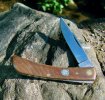
Case EZ 49 Wharncliffe/pen copperhead (thanks, Steve) - Wharncliffe: 6.9cm/10.0cm = .69
Case EZ 49 Wharncliffe/pen copperhead - pen: 4.8cm/10,0cm = .48
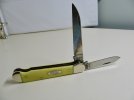
- GT
Rough Ryder brown burlap micarta liner lock work knife (thanks, Alan): 6.2cm/8.8cm = .70

Case EZ 49 Wharncliffe/pen copperhead (thanks, Steve) - Wharncliffe: 6.9cm/10.0cm = .69
Case EZ 49 Wharncliffe/pen copperhead - pen: 4.8cm/10,0cm = .48

- GT
- Joined
- May 20, 2018
- Messages
- 13,657
Is an azimuth like an annulus?Because the tang doesn't have an azimuth.
- Joined
- May 20, 2018
- Messages
- 13,657
Where I heard the word "annulus." Think it's also a mathematical term.
afishhunter
Basic Member
- Joined
- Oct 21, 2014
- Messages
- 14,760
I think a piece of string or a taylor's cloth tape to measure would be faster ... and easier ..
- Joined
- Apr 12, 2009
- Messages
- 13,496
I tried this out of curiosity, inspired by the questions posed about true cutting edge length on blades with more 'belly' curvature. I'd never given it much thought until reading this thread.
(1) Use something like a piece of heavy/thick cardboard, laid flat on a table or bench with one edge flush to the edge of the table. Make an index mark at the edge of the cardboard with a pencil.
(2) Place and hold the blade's cutting edge vertically (spine UP) against the face of the cardboard, with the heel of the cutting edge (like at the plunge) aligned at the mark you made, flush at the edge of the cardboard.
(3) Lift the butt end of the knife upward, allowing the cutting edge's belly curvature to 'roll' forward on the cardboard (without sliding), until the tip of the blade's cutting edge is flush to the cardboard. With a pencil, make a mark where the very tip of the blade lays flush to the cardboard.
(4) Measure from the edge of the cardboard, at the index mark you made there, to the mark you made for the tip.
I just tried this method with a Buck 110LT folder with its upswept tip on a clip blade. I measured 3.375" cutting edge length accounting for the belly, as compared to a straight-line measurement of 3.250" as measured directly from the plunge to the tip. Handle length is 4.875" (4-7/8"). So, accounting for true cutting edge length as I measured it, I'd have this result below, for the ratio of cutting edge length relative to handle length:
3.375" / 4.875" = 0.692
Or, if just relying on the straight-line measurement from the heel of the cutting edge to the tip, as per the OP, I'd get:
3.250" / 4.875" = 0.667 ( Note: I just noticed I typo'd the edge length incorrectly here at 3.125" - edited to 3.25" & recalculated, to fix that. )
I suppose some blades with recurve could be measured in a similar manner, but perhaps against a somewhat radiused or bowed surface to allow full contact along the recurve portion and all the way to the tip. Measure with a flexible ruler.
(1) Use something like a piece of heavy/thick cardboard, laid flat on a table or bench with one edge flush to the edge of the table. Make an index mark at the edge of the cardboard with a pencil.
(2) Place and hold the blade's cutting edge vertically (spine UP) against the face of the cardboard, with the heel of the cutting edge (like at the plunge) aligned at the mark you made, flush at the edge of the cardboard.
(3) Lift the butt end of the knife upward, allowing the cutting edge's belly curvature to 'roll' forward on the cardboard (without sliding), until the tip of the blade's cutting edge is flush to the cardboard. With a pencil, make a mark where the very tip of the blade lays flush to the cardboard.
(4) Measure from the edge of the cardboard, at the index mark you made there, to the mark you made for the tip.
I just tried this method with a Buck 110LT folder with its upswept tip on a clip blade. I measured 3.375" cutting edge length accounting for the belly, as compared to a straight-line measurement of 3.250" as measured directly from the plunge to the tip. Handle length is 4.875" (4-7/8"). So, accounting for true cutting edge length as I measured it, I'd have this result below, for the ratio of cutting edge length relative to handle length:
3.375" / 4.875" = 0.692
Or, if just relying on the straight-line measurement from the heel of the cutting edge to the tip, as per the OP, I'd get:
3.250" / 4.875" = 0.667 ( Note: I just noticed I typo'd the edge length incorrectly here at 3.125" - edited to 3.25" & recalculated, to fix that. )
I suppose some blades with recurve could be measured in a similar manner, but perhaps against a somewhat radiused or bowed surface to allow full contact along the recurve portion and all the way to the tip. Measure with a flexible ruler.
Last edited:
- Joined
- Nov 28, 2012
- Messages
- 8,808
Now do it with a serrated knife.I tried this out of curiosity, inspired by the questions posed about true cutting edge length on blades with more 'belly' curvature. I'd never given it much thought until reading this thread.
(1) Use something like a piece of heavy/thick cardboard, laid flat on a table or bench with one edge flush to the edge of the table. Make an index mark at the edge of the cardboard with a pencil.
(2) Place and hold the blade's cutting edge vertically (spine UP) against the face of the cardboard, with the heel of the cutting edge (like at the plunge) aligned at the mark you made, flush at the edge of the cardboard.
(3) Lift the butt end of the knife upward, allowing the cutting edge's belly curvature to 'roll' forward on the cardboard (without sliding), until the tip of the blade's cutting edge is flush to the cardboard. With a pencil, make a mark where the very tip of the blade lays flush to the cardboard.
(4) Measure from the edge of the cardboard, at the index mark you made there, to the mark you made for the tip.
I just tried this method with a Buck 110LT folder with its upswept tip on a clip blade. I measured 3.375" cutting edge length accounting for the belly, as compared to a straight-line measurement of 3.250" as measured directly from the plunge to the tip. Handle length is 4.875" (4-7/8"). So, accounting for true cutting edge length as I measured it, I'd have this result below, for the ratio of cutting edge length relative to handle length:
3.375" / 4.875" = 0.692
Or, if just relying on the straight-line measurement from the heel of the cutting edge to the tip, as per the OP, I'd get:
3.250" / 4.875" = 0.667 (Note: I just noticed I typo'd the edge length incorrectly here at 3.125" - edited & recalculated, to fix that. )
I suppose some blades with recurve could be measured in a similar manner, but perhaps against a somewhat radiused or bowed surface to allow full contact along the recurve portion and all the way to the tip. Measure with a flexible ruler.
- Joined
- Apr 12, 2009
- Messages
- 13,496
Had that same thought...Now do it with a serrated knife.
Think I'll let that ride for now...
- Joined
- Nov 28, 2012
- Messages
- 8,808
Eventually you would independently produce the same results that Benoit Mandelbrot came up with when thinking about the length of the coastline of Britain.Had that same thought...
Think I'll let that ride for now...
- Joined
- May 16, 2018
- Messages
- 4,183
Wait hold up here a minute! Now we're doing the ACTUAL edge!??I tried this out of curiosity, inspired by the questions posed about true cutting edge length on blades with more 'belly' curvature. I'd never given it much thought until reading this thread.
(1) Use something like a piece of heavy/thick cardboard, laid flat on a table or bench with one edge flush to the edge of the table. Make an index mark at the edge of the cardboard with a pencil.
(2) Place and hold the blade's cutting edge vertically (spine UP) against the face of the cardboard, with the heel of the cutting edge (like at the plunge) aligned at the mark you made, flush at the edge of the cardboard.
(3) Lift the butt end of the knife upward, allowing the cutting edge's belly curvature to 'roll' forward on the cardboard (without sliding), until the tip of the blade's cutting edge is flush to the cardboard. With a pencil, make a mark where the very tip of the blade lays flush to the cardboard.
(4) Measure from the edge of the cardboard, at the index mark you made there, to the mark you made for the tip.
I just tried this method with a Buck 110LT folder with its upswept tip on a clip blade. I measured 3.375" cutting edge length accounting for the belly, as compared to a straight-line measurement of 3.250" as measured directly from the plunge to the tip. Handle length is 4.875" (4-7/8"). So, accounting for true cutting edge length as I measured it, I'd have this result below, for the ratio of cutting edge length relative to handle length:
3.375" / 4.875" = 0.692
Or, if just relying on the straight-line measurement from the heel of the cutting edge to the tip, as per the OP, I'd get:
3.250" / 4.875" = 0.667 ( Note: I just noticed I typo'd the edge length incorrectly here at 3.125" - edited & recalculated, to fix that. )
I suppose some blades with recurve could be measured in a similar manner, but perhaps against a somewhat radiused or bowed surface to allow full contact along the recurve portion and all the way to the tip. Measure with a flexible ruler.
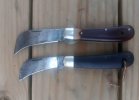
Crud...I gotta start over....

